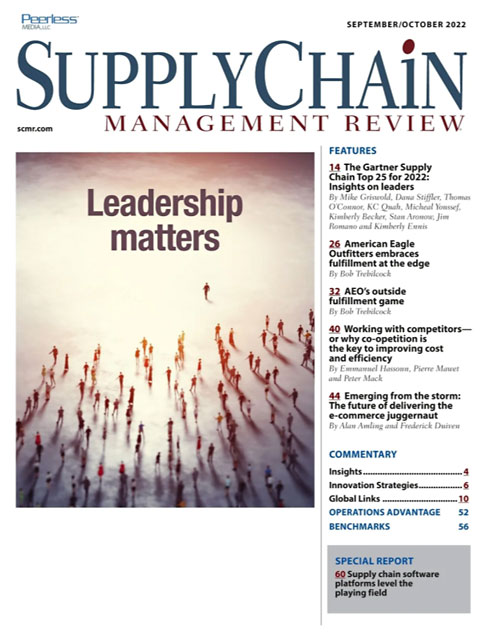Sorry, but your login has failed. Please recheck your login information and resubmit. If your subscription has expired, renew here.
September-October 2022
Once again, it’s time for Gartner’s Top 25 supply chains, the annual list of the 25 supply chains that have made it to the top, plus five Masters that have consistently outperformed year after year. You can read the article, along with some web-only material on scmr.com, to find out what it takes to become a supply chain leader. Last year, I was struck by how the leaders were embracing ESG, or Environmental, Social, & Governance. That has only been reinforced in this year’s report. In fact, ESG has been on the agenda of every event I’ve attended this year, including the keynote address at this year’s ISM conference. Whatever is the… Browse this issue archive.Need Help? Contact customer service 847-559-7581 More options
When supply chain organizations are under huge pressure to improve efficiency, cost of operation and resilience, several traditional options exist: One is to transfer the cost pressure to suppliers and the other is to initiate transformation projects. Both have limitations: Supplier cost reduction quickly reaches a threshold and transformation programs typically require significant investments in all available resources.
The unique business environment we are now facing may require more advanced and innovative solutions, such as the concept of resource sharing across competitors. In such a model, a group of competitors may agree to jointly utilize distribution network facilities, transportation routes, schedules and assets, or even inventory on selected parts or equipment.
There are many benefits and reasons that companies would contemplate this approach, including but not limited to:
- Increased efficiency gains through optimized supply chain assets utilization such as warehouses and trucks;
- cost savings through better bargaining power with providers;
- enablement of new business models generating new sources of revenues;
- ability to adopt the digitization movement at lowered / shared costs, reducing risk, and;
- • higher levels of social responsibility (ESG values) due to less waste and lower carbon footprint.
For example, in offshore Oil & Gas, Accenture research shows that resource sharing could generate $1 billion in cost optimization in the Gulf of Mexico alone and reduce the participants carbon footprints by 25% to 35%. This could apply to other industries with different levels of benefits.
However, embarking on a resource-sharing journey requires overcoming several challenges and addressing seven key success factors.

This complete article is available to subscribers only.
Log in now for full access or start your PLUS+ subscription for instant access.
SC
MR
Sorry, but your login has failed. Please recheck your login information and resubmit. If your subscription has expired, renew here.
September-October 2022
Once again, it’s time for Gartner’s Top 25 supply chains, the annual list of the 25 supply chains that have made it to the top, plus five Masters that have consistently outperformed year after year. You can read… Browse this issue archive. Access your online digital edition. Download a PDF file of the September-October 2022 issue.When supply chain organizations are under huge pressure to improve efficiency, cost of operation and resilience, several traditional options exist: One is to transfer the cost pressure to suppliers and the other is to initiate transformation projects. Both have limitations: Supplier cost reduction quickly reaches a threshold and transformation programs typically require significant investments in all available resources.
The unique business environment we are now facing may require more advanced and innovative solutions, such as the concept of resource sharing across competitors. In such a model, a group of competitors may agree to jointly utilize distribution network facilities, transportation routes, schedules and assets, or even inventory on selected parts or equipment.
There are many benefits and reasons that companies would contemplate this approach, including but not limited to:
- Increased efficiency gains through optimized supply chain assets utilization such as warehouses and trucks;
- cost savings through better bargaining power with providers;
- enablement of new business models generating new sources of revenues;
- ability to adopt the digitization movement at lowered / shared costs, reducing risk, and;
- • higher levels of social responsibility (ESG values) due to less waste and lower carbon footprint.
For example, in offshore Oil & Gas, Accenture research shows that resource sharing could generate $1 billion in cost optimization in the Gulf of Mexico alone and reduce the participants carbon footprints by 25% to 35%. This could apply to other industries with different levels of benefits.
However, embarking on a resource-sharing journey requires overcoming several challenges and addressing seven key success factors.
SC
MR


Latest Supply Chain News
- MIT CTL offering humanitarian logistics course
- Bridging the ESG gap in supply chain management: From ambition to action
- Few executives believe their supply chains can respond quickly to disruptions
- Technology’s role in mending supply chain fragility after recent disruptions
- Tech investments bring revenue increases, survey finds
- More News
Latest Podcast

 Explore
Explore
Business Management News
- MIT CTL offering humanitarian logistics course
- Bridging the ESG gap in supply chain management: From ambition to action
- Few executives believe their supply chains can respond quickly to disruptions
- Technology’s role in mending supply chain fragility after recent disruptions
- Survey reveals strategies for addressing supply chain, logistics labor shortages
- How CPG brands can deliver on supplier diversity promises
- More Business Management
Latest Business Management Resources

Subscribe

Supply Chain Management Review delivers the best industry content.

Editors’ Picks






